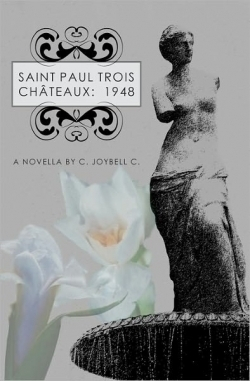Saint Paul Trois Châteaux
1948-
A soft rain drizzles against the windowpanes. A young, attractive couple sits at a polished table in a bar in Saint Paul Trois Châteaux, a French market town located between Marseille and Lyons. Thibaut Desmarais and Lucy Nightingberg sip wine and talk. He plays with his cigar; she picks at a creamy slice of tiramisu. Most of the scenes in C. JoyBell C.‘s novel take place during one evening in the bar, the couple’s favorite haunt, which has the makings of a great setting for the story of a woman’s insecurity and a man’s guilt.
However, to get to this emotional plot, a reader must give up expectations of correct point of view, punctuation, clear sentences, or logical construction. Like a dream or a trance, the book has vivid details, unexpected twists, unknown speakers, and time frames that switch back and forth. The chapters could have been shuffled and scenes inserted in any order. This can be either frustrating, or exciting and wildly compelling for a reader.
The text reads like verses of prose poetry with double lines between each paragraph. The various speakers tell their thoughts, memories, and fantasies; the reader gets the feeling of being in a dream. The novella is set in 1948, but there are not many supporting details of that particular year. With frequent references to physical attributes, clothing, and style, the book’s imagery very often seems unintentionally humorous. An example is this description of Lucy’s appearance: “When it was soft, it was soft and deep. When it was deep, it was deep and deeper. This time, it was deep and deeper.”
Lucy and Thibaut’s dialogue is about trifles, which reveal something deeper. While arguing about the difference between a whore and a bitch, and lingering on the names of four cats, the internal misery of the two young people who have never touched is palpably provocative and powerful. By many references to body parts, especially the eyes, hands, arms and elbows, and on forced smiles and quick tears, the author presents an overall feeling of melancholy. The two characters talk in circles, never really hearing what the other is saying. The repetition and disorganization of the text can be viewed as the way the mind works when trying to hide from truth, pain, or guilt. There is something valuable in Saint Paul Trois Châteaux: 1948, but the reader must be willing to dig and interpret and forgive mistakes to get at the novel’s honest and sometimes touching look at the hope and regret buried inside its wistful characters.
Reviewed by
Mary Popham
Disclosure: This article is not an endorsement, but a review. The publisher of this book provided free copies of the book and paid a small fee to have their book reviewed by a professional reviewer. Foreword Reviews and Clarion Reviews make no guarantee that the publisher will receive a positive review. Foreword Magazine, Inc. is disclosing this in accordance with the Federal Trade Commission’s 16 CFR, Part 255.

